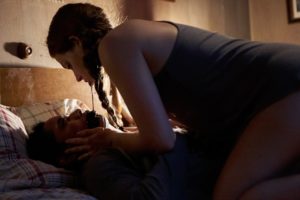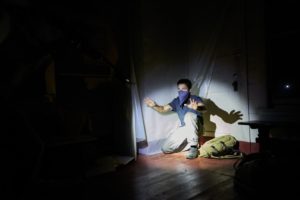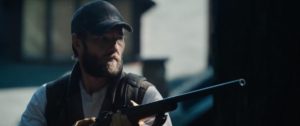A whimper. No fade, no image, no music. Just a whimper. Suddenly, a man’s face. A face decomposed by rotten scabs and black eyes. A muffled voice, crying for the man to let go. The voice of a woman with a gas mask on. The man whimpers. Two masked men carrying the deceased man into the woods. Gunshot. Fire. Title card: “It Comes At Night.”
It Comes At Night begins right in the middle. Humankind has fallen to a mysterious disease, and people are scraping by on pillaging abandoned houses, limited food and water on everyone’s mind. Our lead family lives a methodic post-apocalyptic life, and it’s relatively relaxed outside of Travis (the son) having the occasional nightmare. Their lives change, however, when another family is invited to join them after a series of fortunate and/or unfortunate events. What follows is a tale of family, tension, and—most of all—anxiety.
What writer/director Trey Edward Shults (who also made Krisha for A24 back in 2015) does best is depict the aforementioned anxiety of this world. In the house where our story takes place (it’s unclear whether it was theirs before the disease hit America), they have hung pictures; everywhere Travis goes, particularly in his nightmares, there are still images of his past. Even when worrying about the future, remnants of Travis’ past are omnipotent—in many of his dreams, he finds his grandfather, who was the infected man at the beginning of the film. He can’t escape these thoughts of the past, and meanwhile can’t seem to avoid the lingering fear of what could happen just minutes from now.
The acting should be appreciated just as much as the technical side of things. The powerhouse here is the amazing Joel Edgerton as Travis’ father. He plays a man crippled by fear who utilises his abilities to act as if he’s in charge of the entire situation. It’s a subtle performance, one where facial expressions and slight movements reign supreme; the way he walks, stiff as a board and confident as a pirate, tells us more in one second about his person than we learn about his wife through the whole picture. His wife brought to life the increasingly famous Carmen Ejogo, does not hold back with her performance but has very little character to build off of. Trey Edward Shults focuses a bit too much on the major players in the film and not enough on the smaller ones. The other character who felt one-dimensional (despite being the second billed person) is Will, the father of the other family. Will is a family man through and through, and actor Christopher Abbott’s presence makes him a joy to watch, but once the film ends, the character feels flat. The entire cast did an excellent job, though I wish some of them had a little more to do.
Despite all the wonders that Trey Edward Shults grants to It Comes At Night, there is one massive problem: the film never fully fleshes out its ideas. In its first two acts, Shults places the groundwork for an explosive thematic finale, but nothing ever comes to fruition. Take the idea of our history, which I mentioned earlier when discussing Travis’ anxiety. All over the house are remnants of the past. In Travis’ nightmares are the traces of memories. In his pre-apocalypse life, the father was a history teacher. Paintings of genocide and the black death are even shown early in the film during a montage of Travis falling asleep. The motif of history is everywhere, yet nothing ever comes of it. Because of the half-fulfilled ideas, I can’t find a point to the movie, even to the point where I’m having trouble understanding what it is the disease even represents. The one thing I can figure out is the title, but even trying to dissect that leads you to an inevitable dead end, for the film is relatively theme-less.
Though this critique is a big one, it isn’t enough to detract from just how great the general horror of It Comes At Night is. I’m finding myself more haunted by the imagery in Shults’ movie than that of 2015’s so-called horror masterpiece, The Witch. It Comes At Night is filled with overall good characters, unbelievable acting, a solid script, and brilliant cinematography.
The film may have been made for arthouse audiences, but I have a feeling it will play better with general audiences. The thrills are everywhere, the horror is genuine, and the walk to your car from the movie theatre is scarier than ever.






